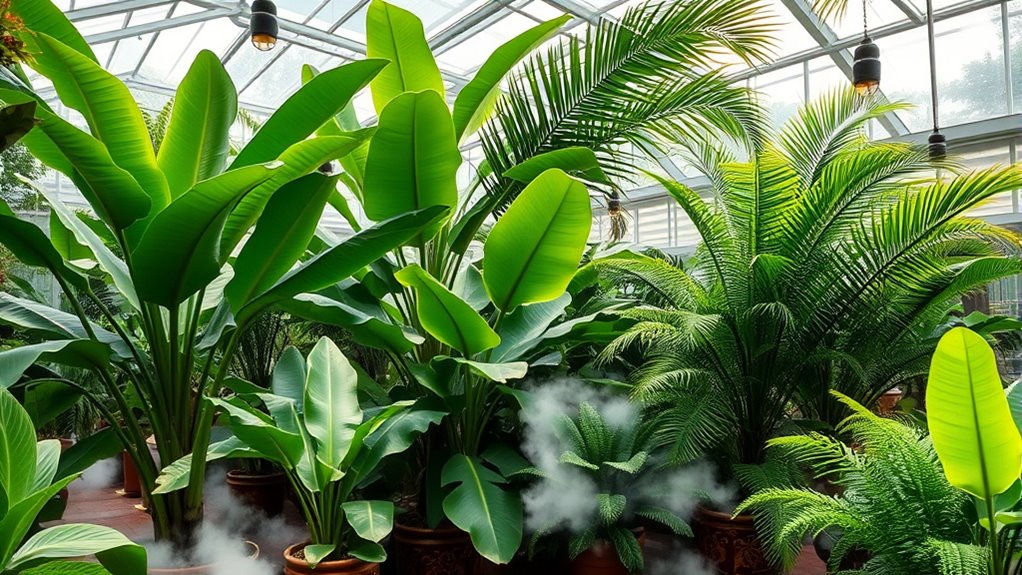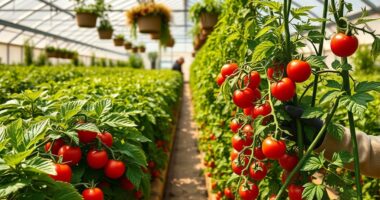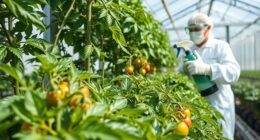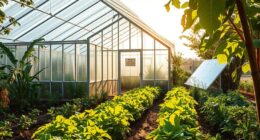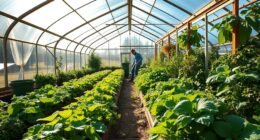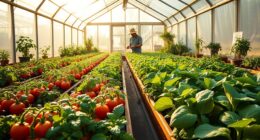To create a humid haven for tropical plants in your temperate greenhouse, focus on mimicking their natural environment by carefully managing humidity, lighting, and air quality. Maintain humidity levels between 60-80% using humidifiers or misting systems, and guarantee your plants receive the right amount of light for healthy growth. Good air filtration keeps your plants healthy and thriving. Properly tailoring these conditions to your specific plants leads to lush, vibrant foliage—keep exploring for more tips.
Key Takeaways
- Maintain humidity levels between 60% and 80% using humidifiers, misting, or water trays.
- Optimize lighting based on plant needs, adjusting intensity and duration for healthy growth.
- Use air purifiers and filters to ensure clean air, supporting plant health and reducing pollutants.
- Mimic rainforest conditions by keeping temperatures warm and consistently monitoring environmental parameters.
- Research each tropical plant’s specific needs and tailor humidity, lighting, and air quality accordingly.

Tropical plants thrive beautifully in temperate greenhouses, where controlled environments mimic their natural habitats. To guarantee they flourish, you need to pay close attention to humidity control and lighting optimization. These factors are essential because they replicate the warm, moist conditions tropical plants rely on in the wild. When you manage humidity properly, you create a lush, thriving environment that encourages healthy growth and vibrant foliage. You can achieve this by using humidifiers, misting systems, or even placing water trays around your plants to maintain consistent moisture levels. Avoid letting the air become too dry, as that can stress your plants and stunt their growth. Instead, aim for humidity levels between 60% and 80%, which is ideal for most tropical species. Regularly monitoring humidity levels and adjusting your watering or misting schedule is key to maintaining stability. Additionally, understanding the specific filtering requirements of your greenhouse environment can help you select the appropriate air purifiers to reduce pollutants and improve air quality for your tropical plants. Similarly, observing how your plants respond to your lighting setup allows you to make necessary adjustments—be it adding more light or reducing intensity—to keep them happy. Remember, each plant species has its own specific needs, so researching their preferred conditions helps you tailor your greenhouse environment more precisely. With consistent effort and attention to these environmental controls, your tropical plants will flourish, transforming your greenhouse into a vibrant, humid haven that feels just like their natural rainforest home.
Frequently Asked Questions
What Are the Best Tropical Plants for Beginners?
If you’re a beginner, start with easy tropical plants like pothos, snake plants, or peace lilies. These species are beginner-friendly and require minimal tropical plant care, thriving in typical greenhouse conditions. They tolerate fluctuations and lower light levels, making them perfect for newcomers. Keep soil moist but not soggy, provide consistent humidity, and avoid overwatering. With a little attention, you’ll enjoy lush, healthy tropical plants in your greenhouse.
How Do I Prevent Pests in a Tropical Greenhouse?
Prevent pests proactively by practicing pest prevention strategies like maintaining clean, clutter-free conditions and inspecting plants regularly. You can also introduce biological pest control methods, such as releasing beneficial insects, to naturally combat pests. Keep humidity levels balanced to deter pests that thrive in damp environments, and quarantine new plants before adding them to your greenhouse. These steps help create a healthy, pest-free paradise for your tropical plants.
What Are Common Mistakes in Maintaining Humidity Levels?
You often make mistakes by not regularly checking humidity sensors, which can lead to inaccurate readings. Relying solely on misting systems without monitoring can also cause fluctuations, stressing your plants. To maintain proper humidity, calibrate sensors frequently and use misting systems wisely, adjusting them based on sensor data. Avoid over-misting or neglecting humidity levels altogether, ensuring a stable environment that keeps your tropical plants healthy and thriving.
Can Tropical Plants Survive Winter Outdoors?
Tropical plants generally can’t survive winter outdoors in temperate regions without seasonal plant protection. You’ll need to bring them inside or create a microclimate for outdoor tropical gardening, such as using cold frames or greenhouse structures. Protecting them from frost and low temperatures is essential. If you ignore these precautions, your plants may suffer or die. So, plan ahead to guarantee your tropical garden thrives year-round, even in colder months.
How Often Should I Water My Tropical Greenhouse Plants?
Think of your tropical greenhouse plants as lush rainforests—they thrive on consistent moisture. You should water them when the soil moisture feels dry to the touch, usually every 2-3 days, but this varies with humidity and temperature. Maintain a steady watering schedule, ensuring the soil stays moist but not waterlogged. Regularly check soil moisture to prevent overwatering or underwatering, keeping your plants happy and healthy.
Conclusion
By creating a humid haven in your greenhouse, you can transform it into a tropical paradise. Imagine growing vibrant orchids or towering ferns right in your backyard, just like a dedicated gardener in Florida who successfully cultivated a lush rainforest ambiance. With the right humidity and care, you’ll enjoy thriving tropical plants year-round, bringing a touch of the exotic to your home. Start experimenting today, and watch your greenhouse come alive with lush, tropical beauty.
